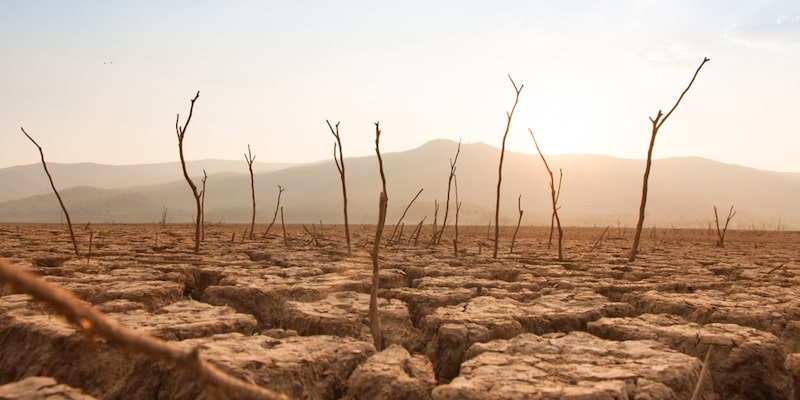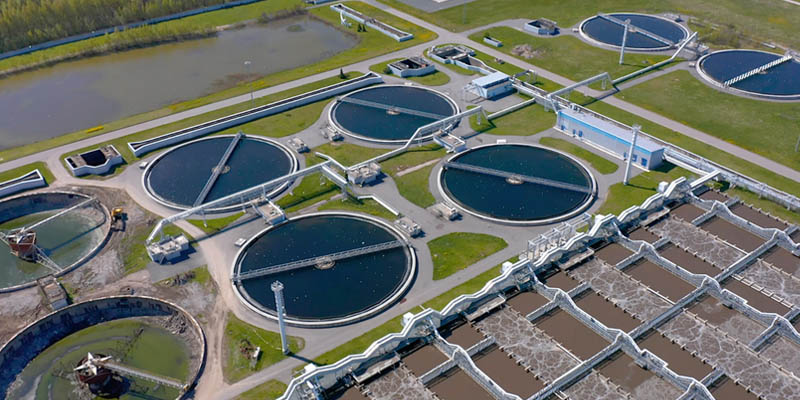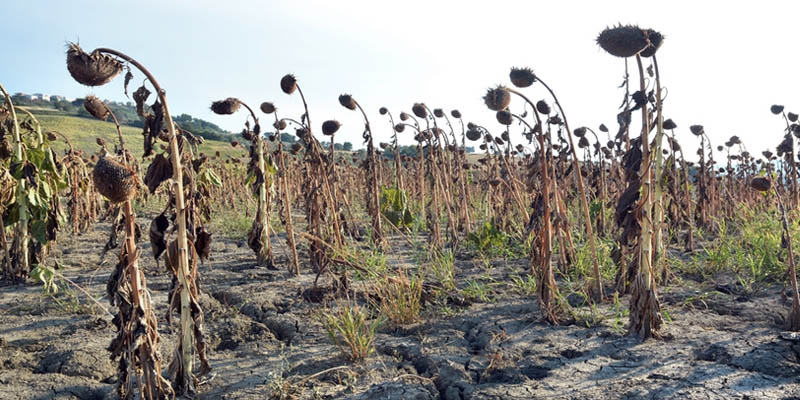We explain what drought is, and explore its types and causes. In addition, we discuss its characteristics and effects.

What is drought?
Drought is a transient and prolonged meteorological anomaly in which streamflow levels in a region fall below the minimum thresholds for sustaining plant, animal, and human life.
Water is not only vital for nourishing life in all its forms (plant and animal), but it is also needed for soil enrichment, the flow of organic matter (as seen in the carbon cycle, for example), and the thermal regulation of our planet.
The causes and effects of droughts are highly complex, linked to both natural factors and human actions. A reduction in precipitation over time significantly alters natural dynamics, affecting both economic activities and the water supply for the population.
To bear in mind: Droughts do not always occur in summer. A drought happens when there is a lack of rainfall, a phenomenon that can occur in any season.
For example, the Mediterranean region experiences droughts in winter and spring, not in summer. In Mediterranean climates, summer is the dry season and, therefore, during the summer it is expected it will not rain. Drought takes place when the season in which rain is expected to occur does not see rainfall or rainfall levels are much below average.
- See also: Flood
Types of drought

Depending on the causes, there are three types of drought:
- Meteorological drought. It occurs when rainfall levels over a prolonged period are significantly lower than the expected average. During a meteorological drought, water available in the soil, lakes, and streams decreases, contributing to cause other types of drought.
- Agricultural drought. It is associated with agro-industrial activities, as it is often the result of a combination of meteorological drought and the overexploitation of soils and water, which may lead to loss of fertility and productivity in fields.
- Hydrological drought. It takes place when the water levels in a region's natural reserves, such as lakes, rivers, aquifers, and reservoirs, fall below the expected average, causing stored water to be used at a faster rate than it can be replenished. This may happen when meteorological drought events extend over prolonged periods of time.
Depending on the environmental impact they cause, droughts can be classified into:
- Dry. Causes minor impacts.
- Moderate drought. Causes some damage to crops and poses a moderate risk of fire. Water level in rivers, lakes, and ponds lowers.
- Severe drought. Leads to losses in crops and pastures, and generates high risk of fire. It often results in water shortages.
- Extreme drought. Causes severe crop losses and the risk of fire increases. It often leads to widespread restrictions on access to water.
- Exceptional drought. Causes widespread crop and pasture losses and extreme risk of large-scale fires. Water scarcity in rivers, lakes, ponds, and reservoirs is complete.
Causes of drought
The primary cause of all forms of drought is a decrease in precipitation in a region, which can be due to various complex climatic factors, such as global warming or phenomena like La Niña or El Niño.
However, the rise in water consumption by humans is also a possible cause of the reduction in available water in regions, especially when humans intervene in river basins, alter soil properties, or intensively use water resources.
Today, 70% of water is used for agricultural activities, 20% for the industrial sector, and only 10% is for domestic use. For this reason, and apart from the reasons that may explain natural droughts, it is vital that the most water consuming sectors do so in a responsible and rational manner.
Effects of drought

Depending on their location, duration, and intensity level, droughts can range from mild to catastrophic for human and animal life. This may have consequences for both human needs and the affected environment as a whole.
The main effects of droughts are:
- Degradation of soil quality. Soils become arid and infertile.
- Reduction in plant and animal life. Many species cannot survive, affecting biodiversity.
- Worsening of human living conditions. People suffer from diseases related to dehydration, unsafe water consumption, poor nutrition, and respiratory illnesses due to increased dust in the air.
- Population displacement. People move to other areas in search of better living conditions.
- Increased food prices. Caused by reduced production and crop losses, which contribute to poverty and famine.
- Wildfires. Increased frequency of wildfires exacerbates drought effects, as the removal of vegetation cover (as is the case with deforestation) leads to soil temperature rise, decreased absorption capacity, and increased erosion.
Drought in the world
There are regions in the world where drought has had a major impact at a social level. For example, the northwest region of the so-called Horn of Africa and the Darfur regions in Sudan and Chad have experienced decades of drought, severely affecting the region’s populations, leading to diplomatic clashes between countries, and sometimes even to war.
In Asia, the melting of glaciers and perpetual snow in the Himalayas as a result of climate change is posing an ever-growing challenge for water access. Reduced ice caps mean increasingly lower water flow in Himalayan rivers.
Several countries in the Himalayan region rely heavily on the water from these rivers for drinking water supply, as well as for agricultural, industrial, and energy purposes. The main ones are India, Bangladesh, Nepal, Bhutan, and Pakistan. It is estimated that drought in this region could affect over 1.5 billion people.
Drought protection

Water resources management involves the implementation of public policies aimed at preventing drought and mitigating its effects. It includes:
- Planning and assessment. Hydrological studies are conducted to determine water availability and the water supply population, and to develop short, medium, and long-term management plans.
- Water conservation. Governments can promote water conservation practices, such as encouraging the use of water saving devices in homes, or controlling and monitoring water use in industry and agricultural activities.
- Diversification of water sources. Countries often invest in the construction of plants for the extraction, purification, storage, and distribution of water from various sources to diversify supply. They may also promote the treatment and reuse of wastewater.
- Water demand management. Governments can implement restrictions on water use when water is scarce, especially among the most water consuming sectors.
- Monitoring and warning. The behavior of the water system can be monitored to forecast drought periods in the medium and long term. This allows countries to implement preventive measures to mitigate effects.
Difference between drought and aridity
The difference between drought and aridity is that drought is transitory, a consequence of lack of rainfall over a period of time, whereas aridity is a climate feature marked by very low precipitation levels of up to 10 inches (250 mm) annually.
Deserts are ecosystems located in regions with arid climates. They are characterized by wide diurnal temperature variation, meaning very high temperatures during the day and very cold temperatures at night. In these environments, both plants and animals develop adaptations to survive these conditions, which is reflected in the presence of plants with deep roots and scaly leaves, and animals with the ability to reduce the need for water, storing it in their bodies.
Climate change
Climate change represents one of the greatest challenges humanity faces today. It is a series of major changes in the world’s climate, resulting from the accumulation of greenhouse gases in the atmosphere.
One of the main effects of climate change is the rise in global temperature. This has a direct impact on rainfall distribution: higher evaporation rates brought about by the rise in global temperature deplete soil moisture and cause drought in some regions, while causing flooding in others.
As a result, droughts are increasingly more extreme and prolonged, and storms more frequent and intense. In addition, climate change may increase the frequency and intensity of extreme weather events such as tropical cyclones and hurricanes.
Water scarcity in the future

Numerous organizations have warned about a future in which water will be much scarcer than at present and, where living conditions will be much more difficult for humans and other forms of life on the planet.
The implementation of public policies for water management has become a priority, as is the regulation, monitoring, and sanitation of polluted waters in lakes, rivers, and streams. To this end, in 1994 the United Nations declared June 17 as the World Day to Combat Desertification and Drought.
This day aims to raise awareness of the importance of caring for natural resources, particularly water and soil, in order to promote the adoption of sustainable practices for managing these resources.
References
- CEPAL. (2019). Agua y cambio climático en América Latina y el Caribe: Escenarios y desafíos para la gestión integrada de los recursos hídricos. Comisión Económica para América Latina y el Caribe
- Valiente, O. (2001) Sequía: definiciones, tipologías y métodos de cuantificación. Revista Investigaciones Geográficas, 26. https://www.investigacionesgeograficas.com/
Explore next:
Was this information useful to you?
Yes NoThank you for visiting us :)